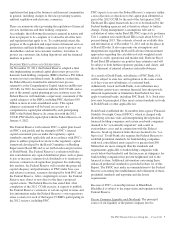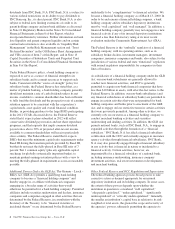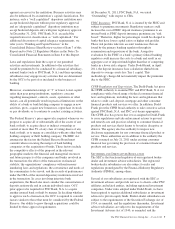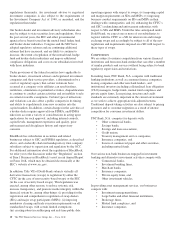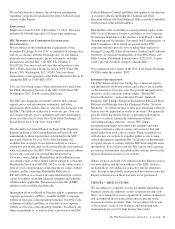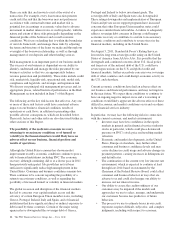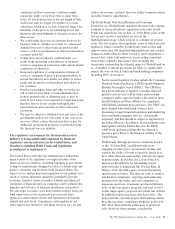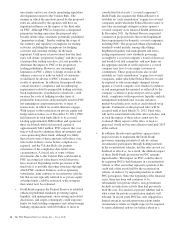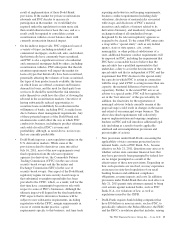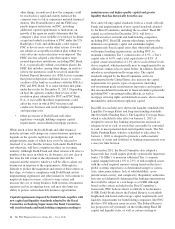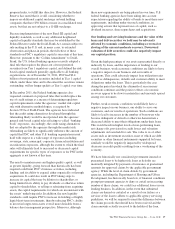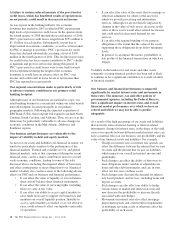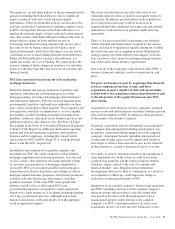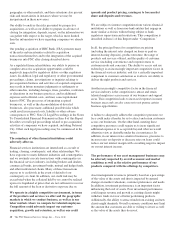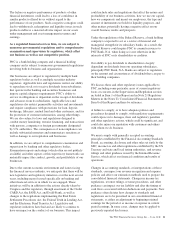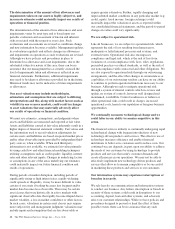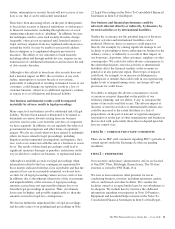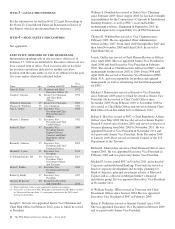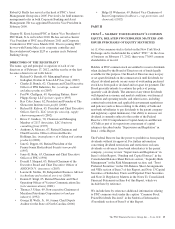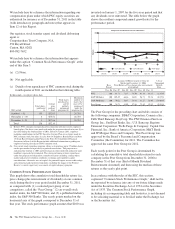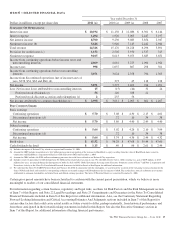PNC Bank 2011 Annual Report Download - page 26
Download and view the complete annual report
Please find page 26 of the 2011 PNC Bank annual report below. You can navigate through the pages in the report by either clicking on the pages listed below, or by using the keyword search tool below to find specific information within the annual report.proposed rules, to fulfill this directive. However, the Federal
Reserve has stated that it is still considering whether to
impose an additional capital surcharge on bank holding
companies that have $50 billion or more in consolidated total
assets, but that are not subject to a G-SIB surcharge.
Because implementation of the new Basel III capital and
liquidity standards, as well as any additional heightened
capital or liquidity standards that may be established by the
Federal Reserve under the Dodd-Frank Act, remain subject to
rule making in the U.S. and, in many cases, to extended
observation and phase-in periods, the full effect of these
standards on PNC’s regulatory capital is uncertain at this time.
However, pursuant to the “Collins Amendment” to Dodd-
Frank, the U.S. federal banking agencies recently adopted a
final rule that requires the phase-out of trust preferred
securities from Tier 1 regulatory capital, and defined the risk-
based capital standards generally applicable to all banking
organizations. As of December 31, 2011, PNC had $2.4
billion of trust preferred securities included in Tier 1 capital
which, under these rules and to the extent the securities remain
outstanding, will no longer qualify as Tier 1 capital over time.
In December 2011, the Federal banking agencies also
requested comment on proposed rules that would replace the
use of credit ratings as a means of determining regulatory
capital requirements under the agencies’ market risk capital
rule with alternative methodologies, as required by
Section 939A of Dodd-Frank. The agencies have indicated
that the credit rating alternatives developed through this
rulemaking likely would be incorporated into the agencies’
general risk-based capital rules affecting so-called “banking
book” exposures. Accordingly, the credit rating alternatives
that are adopted by the agencies through the market risk
rulemaking are likely to significantly influence the amount of
capital that PNC and other U.S. banking organizations must
hold with respect to a wide range of exposures including
sovereign, state, municipal, corporate, financial institution and
securitization exposures, although the extent to which the final
rules will ultimately lead to increased or decreased capital
requirements for specific types of exposures or for PNC in the
aggregate is not known at this time.
The need to maintain more and higher quality capital, as well
as greater liquidity, going forward than historically has been
required could limit PNC’s business activities, including
lending, and its ability to expand, either organically or through
acquisitions. It could also result in PNC taking steps to
increase its capital that may be dilutive to shareholders or
being limited in its ability to pay dividends or otherwise return
capital to shareholders, or selling or refraining from acquiring
assets, the capital requirements for which are inconsistent with
the assets’ underlying risks. In addition, the new liquidity
standards could require PNC to increase its holdings of highly
liquid short-term investments, thereby reducing PNC’s ability
to invest in longer-term assets even if more desirable from a
balance sheet management perspective. Moreover, although
these new requirements are being phased in over time, U.S.
federal banking agencies have been taking into account
expectations regarding the ability of banks to meet these new
requirements, including under stressed conditions, in
approving actions that represent uses of capital, such as
dividend increases, share repurchases and acquisitions.
Our lending and servicing businesses and the value of the
loans and debt securities we hold may be adversely
affected by economic conditions, including a reversal or
slowing of the current moderate recovery. Downward
valuation of debt securities could also negatively impact
our capital position.
Given the high percentage of our assets represented directly or
indirectly by loans, and the importance of lending to our
overall business, weak economic conditions are likely to have
a negative impact on our business and our results of
operations. This could adversely impact loan utilization rates
as well as delinquencies, defaults and customer ability to meet
obligations under the loans. This is particularly the case
during the period in which the aftermath of recessionary
conditions continues and the positive effects of economic
recovery appear to be slow to materialize and unevenly spread
among our customers.
Further, weak economic conditions would likely have a
negative impact on our business, our ability to serve our
customers, and our results of operations. Such conditions are
likely to lead to increases in the number of borrowers who
become delinquent or default or otherwise demonstrate a
decreased ability to meet their obligations under their loans.
This would result in higher levels of non-performing loans,
net charge-offs, provision for credit losses and valuation
adjustments on loans held for sale. The value to us of other
assets such as investment securities, most of which are debt
securities or other financial instruments supported by loans,
similarly would be negatively impacted by widespread
decreases in credit quality resulting from a weakening of the
economy.
We have historically not considered government insured or
guaranteed loans to be higher risk loans as defaults are
materially mitigated by payments of insurance or guaranteed
amounts for approved claims by the applicable government
agency. While the level of claim denials by government
agencies, including the Department of Housing and Urban
Development, has historically been low, if financial conditions
prompt government agencies to deny or curtail an increasing
number of these claims, we could face additional losses in our
lending business. In addition, in the event that submitted
claims are denied or curtailed as a result of our failure as a
servicer of the loan to adhere to applicable agency servicing
guidelines, we will be required to remit the difference between
the claims proceeds that should have been received and the
claim amounts actually received to the holder of the loan.
The PNC Financial Services Group, Inc. – Form 10-K 17


